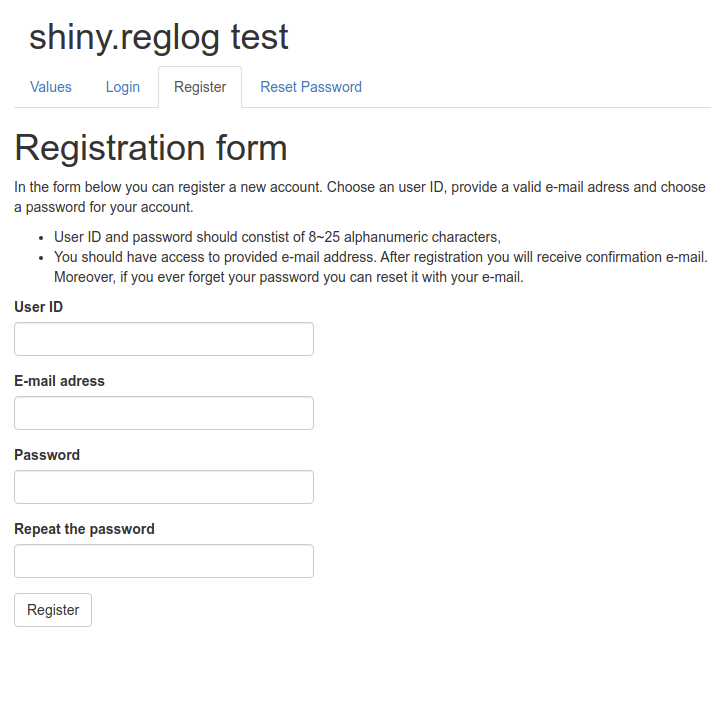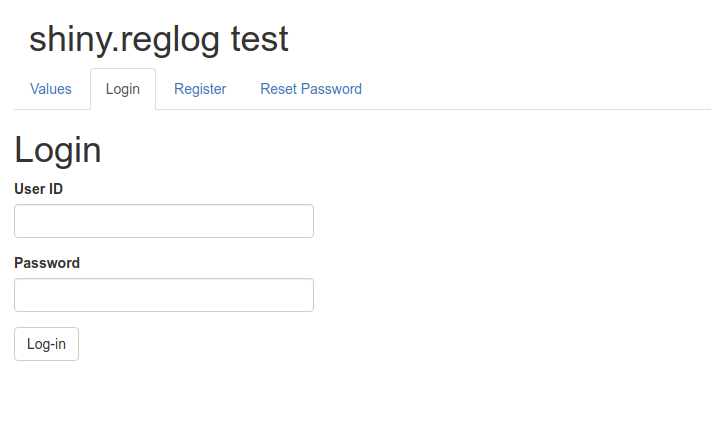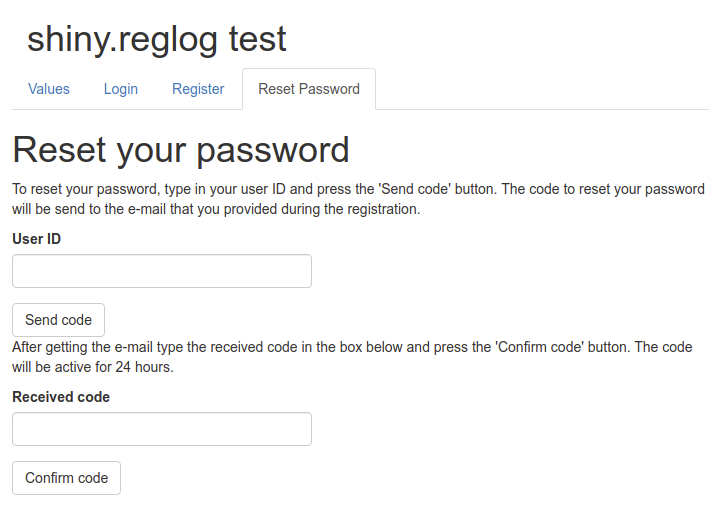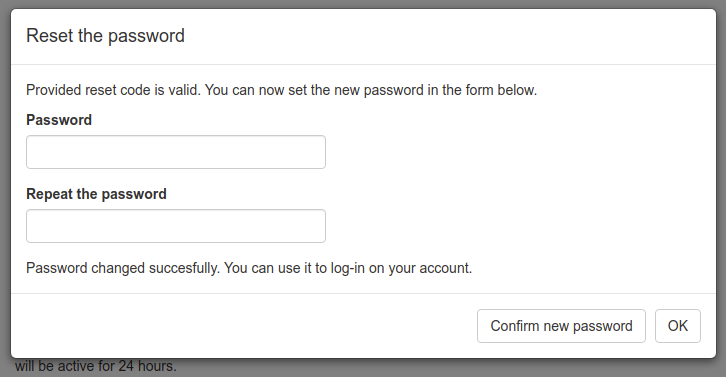The user authentication in Shiny applications can be very useful. Mainly, user can login to read and write some results of their session into relational database.
On the other hand, it may be handy for your App to allow access of unregistered users. If you need to secure your ShinyApp, there are better alternatives (mainly shinymanager package)
This package contains modules to use in your Shiny application allowing you to automatically insert boxes for login, register and password reset procedure. It currently supports two methods for database containers:
- googlesheets for easy of use (via
googlesheets4package) - SQLite database for security and faster use (via
DBIandRSQLitepackages)
Both registration and password reset procedures require confirmation email to verify the user. The package allows two methods of mail sending:
- via
emayilipackage for more flexibility and easier setup but less security - via
gmailrpackage, allowing usage of popular gmail accounts. This method is more secure but the setup can be more tricky: for more information you can check vignette: shiny.reglog: How to get Google API authorization
Currently the package went into stable state, as it have potential of growth without danger of breaking changes. In the future I plan to widen the usability:
- Some kind of admin / levels of authorization for users
- Passphrase for SQLite database
You can install this version of shiny.reglog from GitHub with:
# install version 0.4.0.1 from CRAN
install.packages("shiny.reglog")
# or install latest version from GitHub
# install.packages("devtools")
# devtools::install_github("StatisMike/shiny.reglog")To use the contents of this package, can use helper functions included in the package.
- Create googlesheet file on your googledrive to support database. It creates empty spreadsheet.
# create googlesheet and gather its id for later usage
# you can also specify optional 'name' argument for custom gsheet name
gsheet_id <- create_gsheet_db()
# save you gsheet_id - you need to provide it later to login_server()If you wish to import some credentials, you can do it by giving the
data.frame object to the credentials argument:
# get some credentials
credentials <- data.frame(
timestamp = Sys.time(),
user_id = "ShinyReglogTest",
user_mail = "shinyreglog@test",
user_pass = "VeryHardPassword"
)
# create gsheet database with some credentials
gsheet_id <- create_gsheet_db(
credentials = credentials,
# when giving some credentials, you need to specify if the passwords were hashed by 'scrypt` package
credentials_pass_hashed = F)- Configure googlesheets4 package to use out-of-band (non-interactive)
auth. For more information about it visit googlesheets4
documentation or vignette
provided with
shiny.reglog
Create an SQLite database that your Shiny App will have access to. It creates empty database.
# create SQLite database and gather its filepath for later usage
create_sqlite_db("path/to/db.sqlite")
# you need to provide 'path/to/db.sqlite' later to login_server()If you wish to import some credentials, you can do it by giving the
data.frame object to the credentials argument:
# get some credentials
credentials <- data.frame(
timestamp = Sys.time(),
user_id = "ShinyReglogTest",
user_mail = "shinyreglog@test",
user_pass = "VeryHardPassword"
)
# create SQLite database with some credentials
create_sqlite_db(
"path/to/db.sqlite",
credentials = credentials,
# when giving some credentials, you need to specify if the passwords were hashed by 'scrypt` package
credentials_pass_hashed = F)All functions generates text (input labels, descriptions, authomatic
e-mail). You can control the language of displayed text with lang
argument. Currently it supports English (the default) and Polish
(lang = "pl"). If you want to use non-default language, you need to
set the ‘lang’ argument consistently between all functions of the
package.
All UI functions creates a div element which can be input into UI of
your application, inside a fluidRow, complete fluidPage, tabItem
of dashboard or any other container of your choosing.
The register box contains inputs for user ID (which can be used to link the user with other elements in external databases), e-mail address (which will be used to send confirmation e-mail and reset codes for your password) and for password and password repetition. It tests validity of all inputs and tries to register new account after pushing the “Register” button.
It produces modal dialog detailing the result. Additionally, if registered successfully it sends user a confirmation e-mail.
Currently the functions accept user ID and password consisting of 8~25 alphanumeric characters. It is planned to change in future iterations to widen the requirements - especially for passwords.
Provided password is saved in hashed form - using the
scrypt::hashPassword function.
The login box contains inputs for user ID and password. After pushing the “Login” button, it check validity of inputs and logins user. Produces modal dialog detailing results.
The box for password reset consists of two UI elements: the
password_reset_UI div element and modal dialog it produces after
confirming validity of inputted confirmation code.
The main div contains input for User ID. After user inputs their ID,
they should push “Send code” button, which generates their 24h-valid
resetcode mails it to their e-mail and stores in hashed form in the
database.
After they receive reset code, they need to input it in the next inputbox below and push next button. The validity of inputted code in relation to user ID is then checked. If correct, the new modal dialog opens to input the new password.
The user need to provide new password and repeat it to check for any typos. After pushing the “Confirm new password” button, below input boxes a message is rendered to give feedback to the user - if the password was changed successfully. After that, the user can close modal dialog with “OK” button.
Simple actionButton for your users to log out during ShinyApp session.
Clicking it brings on modalDialog asking if they are sure that they
want to logout.
Currently there is only one server function: login_server()
login_server(
id = "login_system",
db_method = c("gsheet", "sqlite"),
mail_method = c("emayili", "gmailr"),
appname,
appaddress,
lang = "en",
gsheet_file,
sqlite_db,
gmailr_user,
emayili_user,
emayili_password,
emayili_host,
emayili_port
)login_server arguments can be divided into three main groups:
These arguments are always mandatory while using login_server
- id argument defaults to “login_system”. You can use different name - but remember to keep it consistent for all functions
- db_method specify which database method you want to use. At this
moment there are two methods for databases:
gsheetandsqlite - mail_method specify which e-mailing method you want to use. At
this moment there are two methods fo e-mailing:
gmailrandemayili - appname is the character string with title of your application
- appaddress is the character string with URL address of your application for your users to navigate from their confirmation mail
- lang argument defaults to “en”. It changes the language of your modules. Currently only one other option is available: “pl” for Polish
- gsheet_file is the character string containing your googlesheets
ID. Argument is mandatory when using
gsheetdatabase method - sqlite_db is the character string specifying path to your sqlite
database path. Argument is mandatory when using
sqlite
-
gmailr_user is the character string of your gmail address that you wish the application to use for automatic e-mails. Used in
gmailrmailing method -
emayili_user is the character string of your email address, that is also used to log into your mailbox. Used in
emayilimailing method, as the ones below. -
emayili_password is the character string of password that you use to log into your mailbox
-
emayili_host is the character string specifying the sending host of your mailbox (fe.
smtp.gmail.comfor gmail mailbox) -
emayili_port is the character string containing the sending port of your mailbox (fe.
465for gmail mailbox)
login_server function creates reactiveValues object containing three
elements, describing the status of current sessions’ active user.
- is_logged returns a boolean indicating, if the user is anonymous
(
FALSE) or logged in (TRUE) - user_id returns a character string containing the ID specyfied
during registration and used to log-in. When
is_logged = Fit countains the timestamp of time when the anonymous user began his session. It can be used to link specific activities and outputs generated by the same person. - user_mail returns a character string containing the email address
provided during registration. It can be used for automatic sending
the user some kind of e-mails (fe. containing the results of some
analysis after using your ShinyApp). When
is_logged = Fit contains the empty string value ("")
Additionally, it stores the tibbles of user_db and reset_db content
under session$userData inside reactive_db object of reactiveValues
class.
# save the output in the server function of you application
auth <- login_server(...)
# you can check if currently the user is logged
isTRUE(auth$is_logged)
# moreover, you can check what is the ID and mail of currently logged user
user_data <- list(
ID = auth$user_id,
mail = auth$user_mail
)Examples of shiny.reglog implementation with varying methods for
database and e-mail implementation both in base shiny and
shinydashboard are contained within examples folder.
As it is package in very early development, please give any feedback after using it. Open new Issues or mail any suggestions to my e-mail




